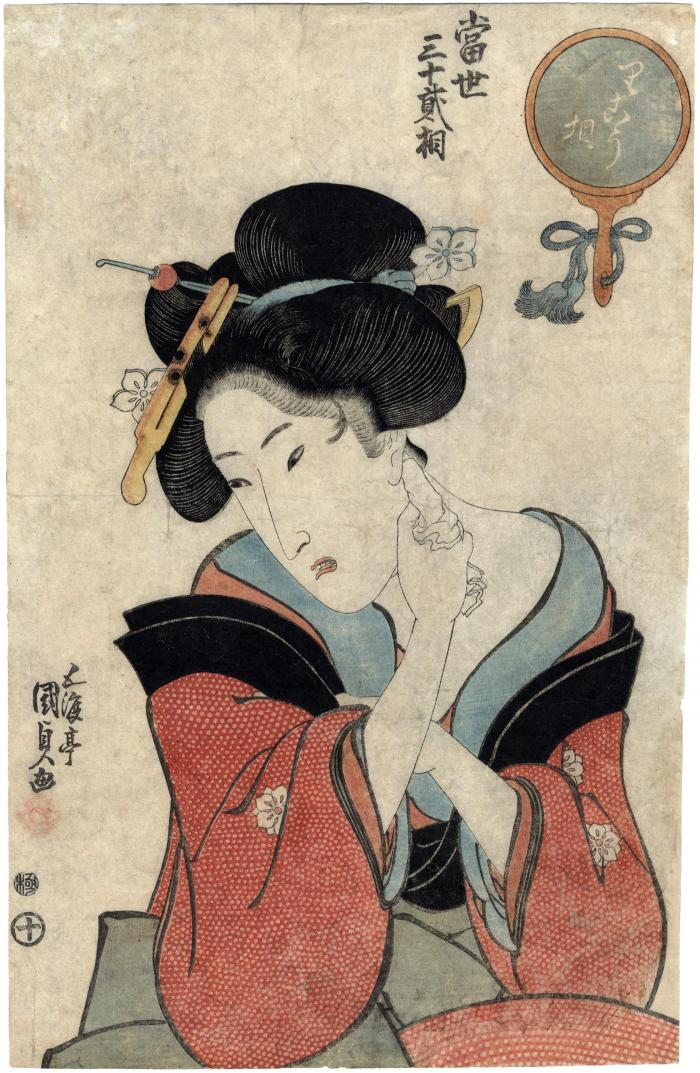Utagawa Kunisada (歌川国貞) / Toyokuni III (三代豊国) (artist 1786 – 01/12/1865)
The Clever Type (Rikō sō - りこう相), from the series Thirty-two Physiognomic Types in the Modern World (Tōsei sanjūni sō - 当世三十弐相)
1821
9.375 in x 14.875 in (Overall dimensions) Japanese woodblock print
Signed: Gototei Kunisada ga
五渡亭国貞画
Artist's seal: toshidama in a matsukawa-bishi or triple lozenge
Publisher: Nishinomiya Shinroku
(Marks 392 - seal 08-078)
Censor's seal: kiwame
Harvard Art Museums
Museum of Fine Arts, Boston
Ritsumeikan University
The National Museum of Asian Art
Hokkaido Museum of Art "The 'Thirty-two Types' of the series title is a reference to the thirty-two marks of the Buddha, a theme introduced into the iconography of ukiyo-e by Nishikawa Sukenobu (1671-1751) in the early 18th century. This set, however, is complete in only ten prints. The cartouche enclosing the print title is a physiognomist's magnifying glass, a conscious borrowing from a series by Kitagawa Utamaro entitled 'Five Facial Types of Beauties' (Bijin gomen sō), published by Tsuruya Kinsuke around 1801. The glass is intended to convey Kunisada's ability to characterize his subjects through their physical appearance and their gestures. Kunisada's attitude is essentially light-hearted, as shown in his choice of titles.
Although the series is difficult to date, it seems likely to have been published in the years 1822-23. Two of the subjects are linked to the Kansai region, suggesting that they were designed after Kunisada returned from Osaka in 1821. The signature can be compared with that in the portrait of Iwai Hanshirō announcing his return to the Edo stage in late 1821. Finally, the drawing style resembles that of a similar series of beauties, the 'Fashionable Makeup Mirror' (Imafū keshō kagami) published by Azumaya Daisuke in 1823.
The early 1820s saw an intense rivalry between Kunisada and Keisai Eisen, the latter having taken advantage of Kunisada's absence from Edo to establish himself as the dominant designer in the field of beauty prints. Eisen, now at the height of his powers, employed much the same subject matter as Kunisada, but his drawing style was more angular and... Kunisada was forced to adapt his own style in order to compete. In their attention to detail, careful execution and expensive materials, his prints during this period suggest a deliberate effort to regain his former status.
'The Clever Type'... is a geisha of the middle rank. She wears a stylish cotton robe printed with an allover orange pattern of tiny tie-dyed dots known as Edo-ganoko, which came into fashion during the Bunsei era. The black silk collar of the robe is loose around her shoulders. In her hair she wears a tortoiseshell pin and comb, a pale blue ribbon, and metal pins decorated with a flower. Flushed with the summer heat or perhpas with the effects of sake, she wipes her neck with a hand towel."
Quoted from: Kunisada's World by Sebastian Izzard, pp. 82-83.
****
Illustrated:
1) in color in The Decadents by Jūzō Suzuki and Isaburō Oka, Kodansha, 1976, p, 23.
2) in "Kunisada and the last flowering of ukiyo-e print" by Ellis Tinois in Print Quarterly, Dec. 1991, vol. 8, p. 346.
3) in 'The art of onnagata in the prints of Utagawa Kunisada' by Ellis Tinios in Andon 26, Summer 1987, #14, p. 40.
Professor Tinios wrote about the contrast between real women and onnagata.
"The particular characteristics of these half-length depictions of onnagata may be better appreciated if they are compared with Kunisada's presentation of bijin (beauties) in the same format. In fig. 14 we have one of Kunisada's most highly regarded half-length bijin, 'the Clever One' from the series Tōsei sanjūni sō ('Thirty-two contemporary marks'), issued about 1822.The bijin lacks the angularity of the onnagata. Her eyebrows and eyelashes are rendered realistically as is her hairline, but the greatest contrast with the onnagata is to be found in the fullness and softness of the bijin's face. In this print, Kunisada is presenting his image of a beautiful woman and not portraying a man seeking to project a synthetic femininity."
4) in black and white in Ukiyo-e Masterpieces in European Collections: British Museum III, supervised by Muneshige Narazaki, Kodansha Ltd, 1988, #11, page 167.
5) in a full-page color reproduction in 歌川国貞:美人画を中心に, (Utagawa Kunisada : bijinga o chūshin ni - Utagawa Kunisada: Focusing on Pictures of Beautiful Women), published by Seikado Bunko, 1996, #59, p. 45
6) in black and white in Kunisada's World by Sebastian Izzard, Japan Society, 1993, page 82.
****
The red matsukawa-bishi (松皮菱) or pine bark, i.e., triple lozenge, motif was used to enclose Kunisada's often used toshidama motif. It also appears in another Kunisada set of surimono prints in the Lyon Collection, but there it is used as the enclosure for the title cartouche.
beautiful woman picture (bijin-ga - 美人画) (genre)
Nishinomiya Shinroku (西宮新六) (publisher)
